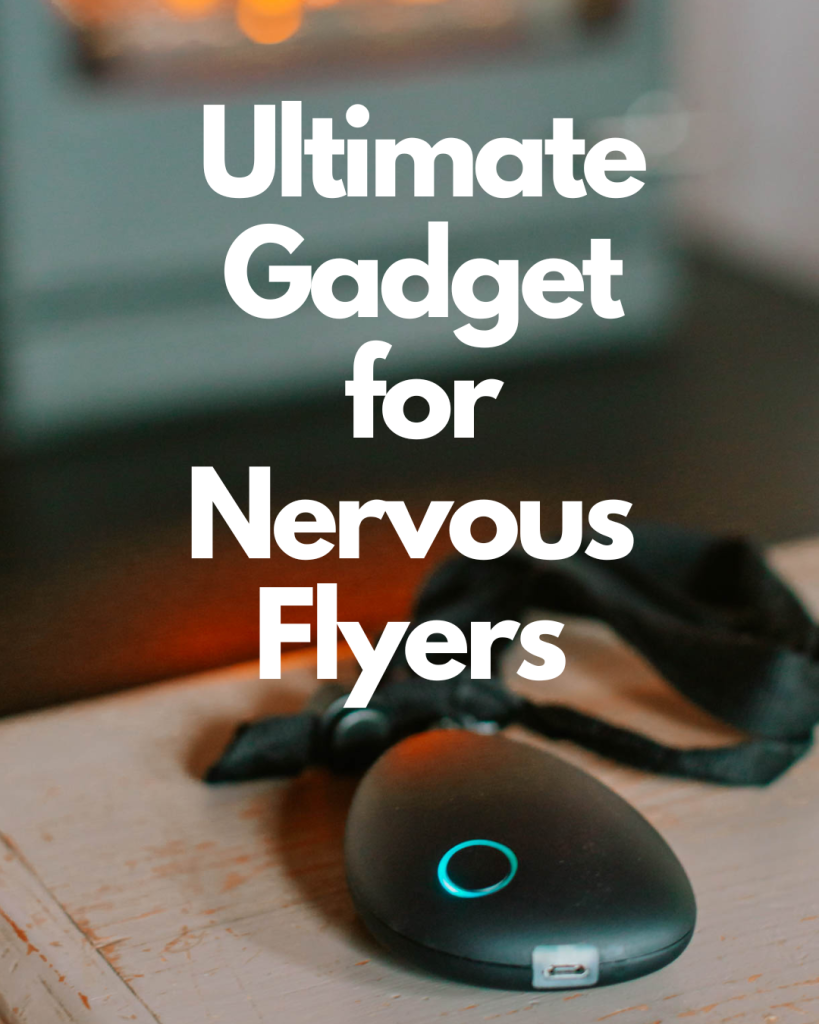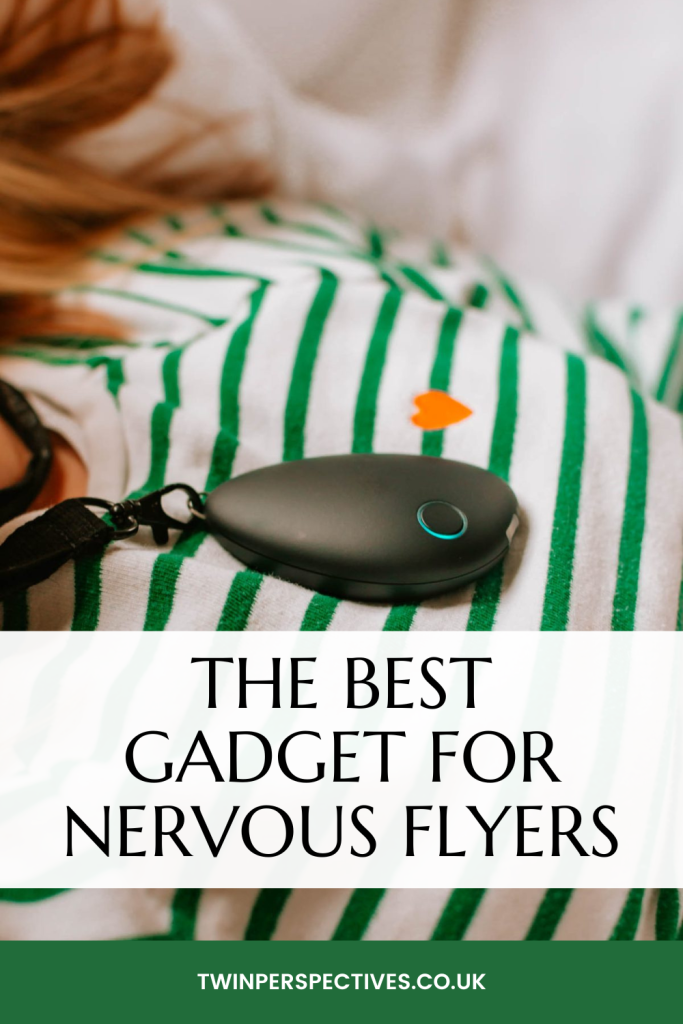As nervous flyers, we’re always on the look out for the best hacks to manage our fear of flying. From journaling to smothering ourselves in natural oils, we’ve tried everything we can to help calm our anxieties about air travel.
Or so we thought.
Last year, we were introduced to the Sensate 2, an anxiety busting device that is taking the wellbeing market by storm. A small, pebble-shaped gadget, the Sensate 2 is said to be able to provide ‘instant calm for an anxious mind’.
It sounded almost too good to be true.
However, since then the Sensate 2 has become a staple of our day-to-day lives, helping us not only manage the stress of everyday life, but manage our fear of flying, too. We’ve now taken our Sensate gadgets on numerous flights and can honestly conclude that the Sensate 2 might just be the best gadget to help nervous flyers.
Read on to find out why.

How Does the Sensate 2 Help Fear of Flying?
Although the human race may appear fairly advanced, the truth is that we’re still cavemen at heart.
You see, our brains are still very much guided by our primitive nervous system (or Stone Age brain). Given that the landscape looked very different all those millennia ago, this system was designed to help save us from very real threats – such as sabre toothed tigers and woolly mammoths. The response triggered by this system was therefore dramatic and immediate – featuring the release of adrenaline and cortisol, so that we could run, fight, focus and battle for our lives.
Today, this response is still very much a feature of our modern-day brain, however the threats facing us have changed significantly.
The result is a feeling of world-ending doom when relatively mild threats cross our paths – flying included.
What is the Vagus Nerve?
Crucial to the fight or flight response triggered by our Stone Age brain is the vagus nerve.
The vagus nerve is the ‘wandering’ cranial nerve that connects our brain to our gut, and is a key player in regulating our stress response. Indeed, it’s the switch that can shift us between panic and calm; fight or rest.
By learning how to better harness our vagus nerve, we can tap into our calming parasympathetic nervous system faster and more effectively.
This is where the Sensate 2 comes in.
What is Vagal Toning?
The Sensate 2 is designed to tone, rather than stimulate, the vagus nerve. Like any muscle, the vagus nerve can be taught and trained (i.e. toned) to do its job more effectively – in this case, to calm and relax our nervous system. The more we tap into it, the quicker we can shift gears – instantly reducing stress and welcoming calm.
The Sensate 2 is placed on your sternum, where the vagus nerve is most exposed in the body. Once in position, it then emits infrasonic resonance (gentle vibrations), that have been proven to effectively and gently activate the vagus nerve – delivering instant relaxation.
When using the Sensate alongside the calming soundscapes included in the Sensate app, the whole experience is blissfully – utterly – relaxing.
How Does the Sensate 2 Help Nervous Flyers?
It’s the primitive fight, flight or freeze response that many of us experience when it’s time to board a flight.
Unaware of the inner intricacies of flying (and the physics behind it) our primitive brain reacts to our own sense of unease as we head up into the skies. This unease is all our Stone Age brain needs to detect a threat – and, being the blunt tool that it is – it immediately deploys its life saving formula of adrenaline and cortisol.
The result? You’re sat on a pleasant, safe flight feeling as though you’re on the brink of a heart attack.
The Sensate 2 can be incredibly powerful during these moments of panic. By placing it on your sternum (and reclining your seat, so that it’s at an angle), you can gently tone your vagus nerve and tap into your comforting parasympathetic nervous system. With the app encouraging slow breathing and mindfulness, the Sensate 2 reassures your brain that you’re perfectly safe.
Within moments, you’ll feel your body calm as dreamy dopamine floods your body and your anxiety ebbs away.
Practice Makes Perfect
As with any exercise, the more you use your Sensate 2 to tone your vagus nerve, the more effective it’ll be in future. We’d therefore advise that you get used to using the Sensate a few weeks before your flight.
Not only does this give you the opportunity to get your vagus nerve primed for deployment, it also lets you get to grips with the device.
Having now used the Sensate 2 for over 6 months, I’ve found that the moment I hear the familiar soundscape of the ‘Forest’ (on the Sensate app), I can already feel my body relaxing. My brain instantly recognises its music and gentle hum, and I’m able to move into a relaxed state much faster.
When is the Best Time to Use the Sensate on a Flight?
The Sensate can be used at any point when you’re feeling nervous on a flight. We’ve used the Sensate 2 during takeoff, during periods of turbulence and when we just want some help getting to sleep.
With your headphones in, a calming meditation track playing and the hypnotic buzz of the Sensate on your chest, you really can block out the world around you. This has been particularly useful during takeoff, when we don’t want to hear the ominous sounds of the plane whirring and clunking.
Before the flight, take some time to therefore explore the different soundscape options available on the Sensate app and download those that you like best. Personally, we think the ‘Breathe’ series is ideal for moments of anxiety, i.e. during take off or during turbulence. Likewise, the ‘Space and Time’ series brilliant for encouraging deep relaxation and sleep.
You can also pick the length of your session, from a quick 10-minute refresher, to a longer 30-minute session if you’re really looking to escape your surroundings.
Will Other Passengers Know I’m Using the Sensate Device?
One of my initial worries before using the Sensate on a flight was whether it would be obvious I was using it. I had visions of curiously loud vibrating noises escaping from under my jumper, as plane passengers eyed me suspiciously. I was worried the whole thing might be a little embarrassing.
As it turns out, no one is yet to bat an eyelid when I’ve used my Sensate 2 on a flight.
To use it, I simply pop the lanyard around my neck and put the Sensate under my jumper. If I can, I recline my chair so I can get the device in its optimum position and if need be, gently hold it in place with my hand (over my jumper). The vibrations are incredibly quiet and thanks to the louder hum of the aircraft, are pretty much muted.
All that’s left to do is to then put my headphones in, close my eyes and relax as the calming vibrations and soundscapes transport me away.
For anyone sitting next to you, you’re just another passenger relaxing with your headphones in.
The Sensate Plus Pack
Since we started trialling our Sensate 2 devices, an addition to the Sensate app has been released – the Sensate Plus Pack. This comes at an additional cost of £49.99 per year and offers new monthly tracks, including specific tracks for sleep, anxiety and travel.
I haven’t trialled the new pack yet and although it would be nice to have a selection of new tracks to listen to, I find it oddly comforting returning to the same soundscapes again and again.
If you’re just using the Sensate 2 to help manage your fear of flying, I wouldn’t say that you urgently need this premium pack. However, the travel tracks do look quite interesting, so you might want to try them later down the line.
Our Experience of Flying with the Sensate 2
As nervous flyers, we felt that there was a lot riding on the Sensate 2 device when we flew with it for the first time (to Iceland).
Although we were already reaping the rewards of using it as part of our day-to-day routine, we were more apprehensive when it came to depending on it during moments of intense anxiety.
Could this little device really subdue our brains into relaxation? Even during significant turbulence?
As it turns out, yes – absolutely.
Transporting you into your own world of soothing sounds and good vibrations (quite literally), the Sensate is the ideal gadget for nervous flyers. Taking the edge off the initial nerves we often feel as we board a flight, we usually use the Sensate during takeoff, when our flight or fight mode is activated.
Although it doesn’t entirely remove all feelings of nervousness, it ushers us back from the brink of that more intense panic. Our anxiety is therefore jangling, but not all-encompassing.
As well as using it during takeoff, the Sensate also works wonders to beckon in sleep (something that often feels impossible on a flight). Helping you to sink into your own cosy space of relaxation, the Sensate has sent us off to sleep on occasions when we’d usually be sat bolt upright, biting our nails.
Although it’s certainly not a cure for a fear of flying, the Sensate 2 definitely reduces the uncomfortable sensations we feel as nervous flyers. Teaming the Sensate up with the other techniques we use to manage anxiety – such as CBT and grounding exercises – this magic little device has provided us with some of the most calming flight experiences to date.
Pin for later: Is this the Ultimate Gadget for Nervous Flyers?

